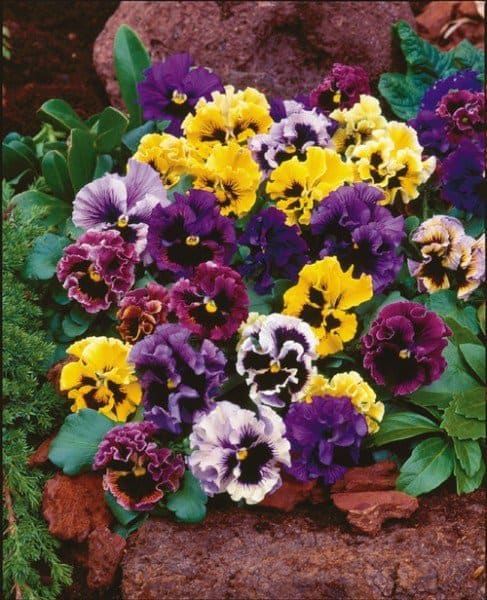
Are there any further surprises in store? Another unexpected snowfall, a sudden Ice Age, a plague of toads? I don’t care, I simply can’t wait any longer for my annual pansy purchase. Being a fool for violets of all kinds, I’m especially keen on pansies, and as early as possible in spring. Garden centres and almost every corner store are flooded with so many choices in size, petal shape, colour and style that it’s quite hard to make choices. I could buy some of everything, but admittedly my planting venues are finite. I plant pansies in containers where I can give them the moist organic soil they prefer; not the ground where I would have to wait weeks longer for ideal planting conditions.
This spring I was looking for ruffled pansies, which until recently have been inconsistently available. The older Victorian-style Chalon Series, with dark colours, white petal edges and almost crimped ruffles, have been further hybridized to include a broader colour range, and include ‘Chalon Improved’, ‘Chalon Supreme’, and ‘Super Chalon Giants’. You might also find ‘Can Can’, ‘Contessa’, and possibly other ruffled pansies I haven’t yet discovered. I can’t say what the differences are between these newer cultivars, but I do notice that they aren’t as deeply frilled or ruffled as the older Chalon Series. Some are better described as wavy (not truly ruffled), and as is often the case in plant breeding, one characteristic is minimized when another, such as colour range, is increased. With all ruffled pansies, the petal edges are more deeply frilled when grown in cooler weather — below 12°C — consequently they’re ideal plants for a cold Canadian spring.
This week I found ‘Frizzle Sizzle’, a Viola x wittrockiana hybrid, and I’m a happy gardener. Perhaps more thought could have gone into the name… But what’s in a name, when a pansy incorporates so many charming features? The breeder, Kieft Pro Seeds in the Netherlands, describes these three-inch (8-cm) flowers as fringed, but that’s not how they appear to me. I think they’re deeply waved and ruffled. I won’t quibble over semantics, particularly when their darkly blotched and whiskered faces are bouncing before me, in gorgeous plumy burgundy, bright blue, raspberry-pink, apricot-orange and yellow bi-colour blends. And did I say that they’re fragrant? Bless us and save us, but these are gorgeous pansies!
Edging the lawn
Clouds of stone dust from nearby construction severely curtailed maintenance activities in my garden last summer. Now the neglect is all too obvious and much work is necessary to dispel the Tobacco Road appearance. I need some quick magic to distract from the overgrown and dishevelled state of affairs. Containers of pansies certainly brighten the place, but my big trick is to give the lawn a three-inch (8-cm)-deep, razor-sharp edge. A clearly defined edge immediately organizes the space and makes a clean and well-kept impression (regardless of what chaos is going on in the beds). Some gardeners wait until the beds are clean and all is orderly before putting the finishing touch of an edge on the lawn. But I edge first and then carry on with cleaning, feeling some relief and encouragement from the instantly improved appearance. The short blade of a half-moon edger isn’t sufficient to cut a deep edge; I use a standard blunt-end spade to cut down along the lawn.
There is a practical reason to edge the lawn as early as possible in spring. You may notice persistent, perennial weeds are actively growing under the last vestiges of snow—they laugh at frost and thrill to the early spring sun! Those that spread by underground rhizomes have been pressing forward to colonize new territory while gardeners are still clustered inside the window, watching for the weather to warm up. My worst weeds are creeping buttercup (Ranunculus repens), yellow avens (Geum aleppicum) and creeping speedwell (Veronica filiformis), all shallow-rooted and rampant in the beds, and rapidly moving by root or seed into the lawns. Cutting a deep edge to the lawn is a good way to intervene in the early expansion of these armies, as I crawl along behind, attempting to rip and plunder their reserves. When order is restored to the beds and all is clean and tidy, I finish by overseeding the lawn and covering the grass seed with one-half-inch (1-cm) of peat moss. The deep edge on the lawn keeps the lawn seed in the turf, preventing it from straying into the beds. A sharp line around the lawn is a wonderful thing!
I’m glad you stopped by Making a Garden, and hope you’ll visit again next week.









I’ve been using these frilly pansies for quite a while. First, because of their sweet scent, and secondly, because the blues are a perfect companion planting with agapanthus. Unfortunately, our transition from winter to spring was too fast this year and they were in short supply in our area. I’m going to miss their happy little faces at my back door.
Thanks for your advice on the ruffled pansies, Ms. Adam. I’ll let you know if I was successful in finding some in my area… Also, loved your article on tulips/daffodils that no longer flower. Will follow your advice re fertilizing. Happy Gardening!!
Thanks for your advice on the ruffled pansies, Ms. Adam. I’ll let you know if I was successful in finding some in my area. Also, loved your article on tulips/daffodils that no longer flower. Will follow your advice re fertilizing. Happy Gardening!!
To Beverley (April 28),
I’m just at loose ends when it comes to garden centres in Montreal… The best thing to do is go to large garden centres that carry a broad selection of pansies, and you’ll likely find some. For the planters, use a peat-based soilless mix, purchased in a bag. This sort of soilless mix is used for starting seeds, and also is good for box plants like the pansies and other summer annuals. You’ll need to fertilize them every three weeks. Hope you have good luck and find the ruffles!
Lynne,
I think any nursery with a large selection might have some. I did see them at Sheridan Nurseries. Hope you find some.
I am nuts about spring and gardening, and have been anxiously awaiting pansies, to put in my front planter until my summer annuals are ready!!
Any chance I can find these "ruffled" pansies in the West Island of Montreal, or west of the Island of Montreal?? What sort of soil do you suggest planting in, i.e. potting soil??
Thanks so much
Are there any sellers located in the Toronto area for ruffled pansies?
We are living in Fort McMurray presently and would like to know if you could
help me find the closest place to purchase the the ruffled pansies.
Hello Zela: Unfortunately, I'm not familiar with the nurseries or garden centres near Fort McMurray. Perhaps one of our readers in your area will see your comment here and offer a suggestion or two. Good luck with the search.
Thanks, Judith! Leave it to you to search (sniff?) out ruffled pansies, even in Fort McMurray.
Hello Zela (April 26)
You're in luck! Dunvegan Gardens (128 Garden Lane, off Draper Rd.) carries 'Masterpiece' ('Chalon Supreme Mix') pansies, and they are quite ruffled. Here is the web site for their Fort McMurray location: http://www.dunvegangardens.ca/HomepageFM.htm .
Good Luck, and remember — the early bird gets the ruffled pansies!
— Judith
Hi Clare (April 15)
One important detail is to use a blunt- or square-edge spade, and not a pointy-ended shovel. Pressing with your foot, thrust the spade vertically straight down at the edge of the lawn. Then pull the handle back and you’ll open a neat V-shaped valley between the lawn and growing bed. The spade will heave up some soil, which can either be thrown forward into the bed or put in a wheelbarrow to take elsewhere. Then set the spade directly next along the edge of the lawn and do it again. Keep going until you get around the lawn. Thrusting the blade deeply will create a flat three-inch (8-cm)-deep cut along the lawn, and effectively remove enough soil to prevent plants and weeds moving between the bed and lawn. It will look like a dark, neat line around the lawn. To keep the neat appearance, you’ll need to freshen up the line in some areas every three to four weeks.
You can edge in straight lines or in curves, depending on the lawn’s shape. You can change the shape by first laying down a rubber hose to show a new line, and then cut along that with your spade. If you’re planning to remove grass and widen the bed, you’ll need to lift some turf. Lay the spade flat and horizontal to the soil, and force it under the turf, lifting out flat pieces of sod that can be transplanted to bare areas where needed (or composted in a pile). This is all easier than it sounds!
I understand cutting a deep line to separate the garden and the lawn. How do you make it LOOK as though a nice neat line has been cut and maintain that visual separation? Thanks!